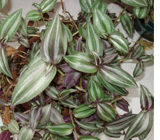 Tradescantia refers to herbaceous plants with straight or creeping shoots. The family - Commeline, which unites about 30 different species. Tropical regions of America are considered to be their homeland.
Tradescantia refers to herbaceous plants with straight or creeping shoots. The family - Commeline, which unites about 30 different species. Tropical regions of America are considered to be their homeland.
Tradescantia of different species are characterized by ovoid leaves, slightly pointed at the end. The leaves often have white or yellow-gold veins. This plant is unpretentious and grows well at home. It is best if you place the Tradescantia pot on top of a cabinet, on hanging flower holders, or in a planter so that the shoots can hang freely.
With proper care, tradescantia can bloom, for example, purple-blue flowers appear in tradescantia verginskaya. Among other popular tradescantia are Anderson, Blossfeld, zebra-shaped, white-flowered and others.
The plant feels great in fairly bright places and in the shade. Please note that if you have a variegated Tradescantia, then it needs more light than other species. Otherwise, with its deficiency, the leaves lose their color and become dark green.
As for watering, the recommendations here are general, as for many other indoor plants. In the hot summer season, it is better to water every three days or focus on the topsoil: as soon as it is dry, watering is required. It is clear that in cool weather it should be watered less often. The remaining water seeped into the pan is drained.
Top dressing is carried out during the period of active growth from April to August with a frequency of once every two weeks. At the same time, both organic (only not for variegated species, in order to avoid color loss) and mineral fertilizers are used.
Transplantation is done at intervals of once a year, for older plants - every two to three years. For transplantation, you can purchase a special soil prepared for Tradescantia, or mix deciduous (most) and soddy soil with the addition of humus and sand. Put a drainage layer on the bottom.
Reproduction of tradescantia
It is well propagated by cuttings, on which shoots of medium length go. Planted for rooting in pots of several pieces. Land for cuttings is prepared interspersed with humus and sand. You can also hold the stalk in water until the roots appear and land.
If the plant does not have enough light and moisture, then it will go into shoots with a small number of leaves. The leaves turn yellow if the flower is watered irregularly. Dry air also leads to dry leaves: do not forget to spray. The optimum temperature in the room is from 15 to 25 degrees.
Houseplant Care
![]() Transplanting Houseplants
Transplanting Houseplants
![]() Flower Pots: How to Choose
Flower Pots: How to Choose
![]() Houseplant Pests
Houseplant Pests
![]()
![]()
Houseplant Propagation Houseplant
![]() Fertilizers Hydroponics
Fertilizers Hydroponics
![]() Alocasia
Alocasia
![]() Aloe
Aloe
![]() Pineapple
Pineapple
![]() Araucaria
Araucaria
![]() Asparagus
Asparagus
![]() Aphelandra
Aphelandra
![]() Begonia
Begonia
![]() Geranium
Geranium
![]() Dieffenbachia
Dieffenbachia
![]()
![]()
Dracaena
![]() Cacti
Cacti
![]() Kalanchoe
Kalanchoe ![]()
Euphorbia
![]() Monstera
Monstera
![]() Tradescantia Ficus
Tradescantia Ficus
![]() Cyclamens
Cyclamens
PS If you liked the article, please press the buttons of social networks.

Leave a comment